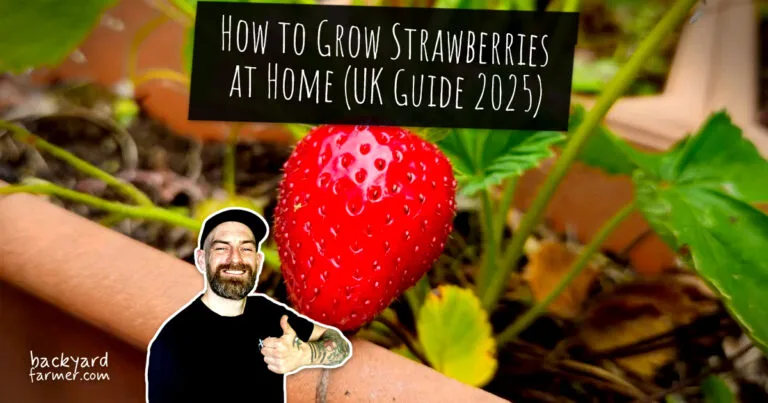Table of contents
- How to Grow Strawberries at Home (UK Guide)
- Why Grow Strawberries at Home?
- When to Plant Strawberries in the UK
- How to Plant Strawberries at Home
- How to Care for Strawberry Plants
- Common Strawberry Problems (and How to Fix Them)
- When and How to Harvest Strawberries
- Can You Grow Strawberries from a Strawberry?
- FAQs: Growing Strawberries at Home
- Final Tips for a Successful Strawberry Patch
How to Grow Strawberries at Home (UK Guide)
There’s nothing quite like biting into a fresh, juicy strawberry you’ve grown yourself. Whether it’s for the flavour, the savings, or the simple satisfaction, learning how to grow strawberries at home is one of the most rewarding and enjoyable things you can do in your garden. And despite what some might say, it’s surprisingly easy — especially in the UK climate.

Homegrown strawberries are ideal for all kinds of spaces: gardens, containers, window boxes, and even hanging baskets. With a little planning, you can enjoy ripe, fresh fruit throughout the season — and, with a bit of luck, even encourage a second crop later in the year.
In this beginner-friendly guide, we’ll show you exactly how to grow strawberries at home in the UK, step by step — from choosing the best varieties to harvesting sweet, sun-ripened berries.
You don’t need a greenhouse, specialist equipment, or loads of space. All it takes is a sunny spot, the right planting method, and a few reliable tips to get you started.
Looking to plan out your strawberry patch and other crops? Check out our free allotment planner with companion planting tips — it’s the perfect tool to map out a productive, well-balanced garden.
Why Grow Strawberries at Home?
Strawberries from the supermarket rarely hit the mark. When you grow your own strawberries at home, you get sun-ripened berries picked at their peak — full of flavour, not bred for shelf life or transported across the country.
But there’s more to it than just taste. Here’s why more and more people in the UK are turning to homegrown strawberries:
1. Better Flavour, Naturally
Homegrown strawberries are sweeter, juicier, and more fragrant. Supermarket strawberries are usually picked before they’re ripe and chilled during transport, which dulls their flavour. When you grow strawberries at home, the berries ripen naturally on the plant and go straight from garden to bowl.
2. Easy to Grow in Small Spaces
Strawberries don’t need much space. Got a balcony, patio, or even just a few pots? Perfect. They grow really well in containers, hanging baskets, grow bags, or vertical planters — ideal for urban gardens, courtyards, or small-space gardening.
3. Save Money Over Time
Organic strawberries can be pricey. But once your plants are established, they’ll keep producing fruit year after year — especially if you replant the runners. It’s one of the most cost-effective crops to grow at home.
4. Great for Kids (and Curious Adults)
Strawberries are fun and rewarding to grow. They’re a brilliant way to introduce kids to gardening. Watching them grow from flower to fruit is exciting, and picking them is half the fun. Plus, they’ll be more likely to eat them!
5. Fewer Chemicals, More Control
You choose what goes into your soil and onto your plants. That means you can skip the pesticides and synthetic fertilisers and use compost, organic feeds, or natural pest deterrents instead.
6. Longer Strawberry Growing Season
With the right varieties, you can enjoy strawberries from May to October. By planting a mix of early, mid, late, and everbearing types, you extend the harvest over a much longer season.
In short, growing strawberries at home is easy, rewarding, and works in even the smallest of spaces. Next, we’ll help you pick the best strawberry varieties for the UK climate and your garden setup.
Best Types of Strawberry Plants for UK Gardens
If you want a longer strawberry season and reliable harvests, choosing the right strawberry varieties makes all the difference. Some types fruit early in the year, while others peak in summer — and a few can even give you two or three crops with a little extra care.
By growing a mix of strawberry plants, you can stretch your harvest from spring well into autumn.
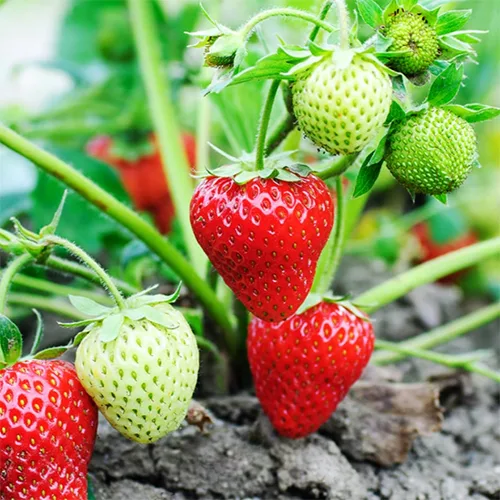
Early-Season Strawberry: ‘Vibrant’ 🍓
‘Vibrant’ is one of the earliest strawberries you can grow in the UK — ready to pick from late May. It’s vigorous, disease-resistant, and produces sweet, firm fruit.
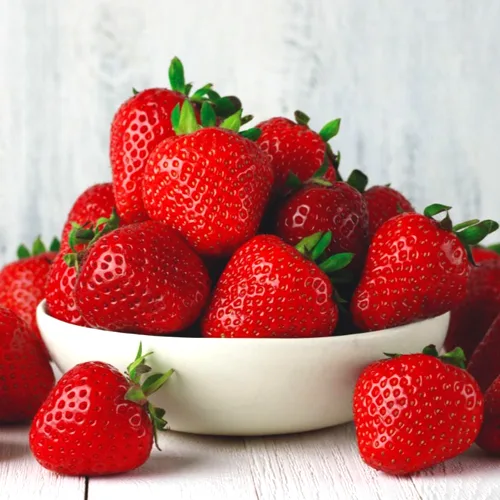
Mid-Season Strawberry: ‘Cambridge Favourite’ 🍓
‘Cambridge Favourite’ is a time-tested British variety that fruits heavily from mid-June. Great flavour, reliable crops, and perfect for growing in pots or borders.

Late-Season Strawberry: ‘Malwina’ 🍓
Looking for late crops? ‘Malwina’ is your go-to. This late-season variety produces large, deep-red fruit from late July into August — full of rich flavour.
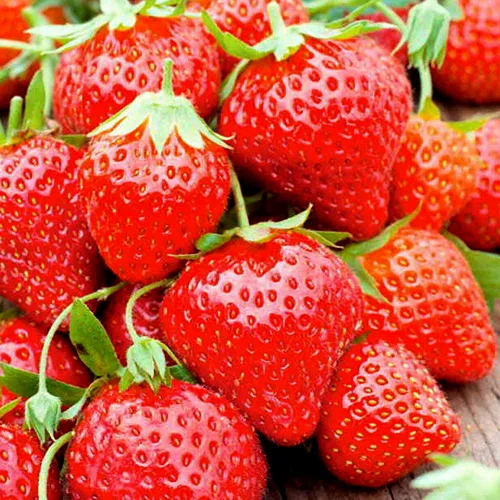
Ever-Bearing Strawberry: ‘Mara des Bois’ 🍓
‘Mara des Bois’ is a flavour-packed everbearer — producing aromatic, sweet strawberries from summer through to autumn. It’s perfect for pots, borders, and anyone who loves that old-fashioned strawberry scent and taste.
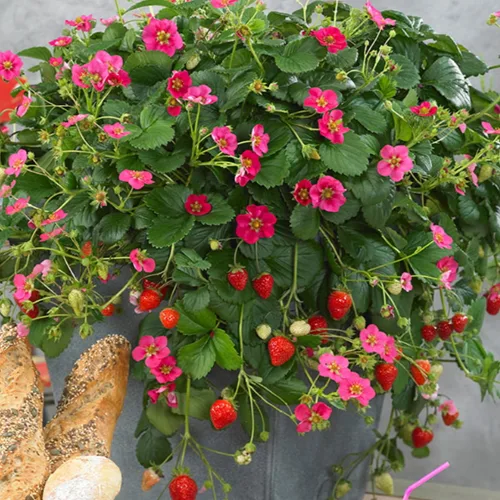
Day-Neutral Strawberry: ‘Toscana’ 🍓
‘Toscana’ is a beautiful, pink-flowered variety that fruits regularly in warm conditions. It’s compact, ornamental, and perfect for containers or balcony gardens.
Quick Tip: Mix Your Varieties for a Longer Harvest ✅
To maximise your strawberry growing season, plant a mix of early, mid, late, and ever-bearing types. That way, you can enjoy fresh strawberries from May right through to October.
Next up: When to plant strawberries in the UK for the best results in your garden or containers.
When to Plant Strawberries in the UK
Timing is everything when it comes to growing strawberries successfully. In the UK, where the weather can be unpredictable, knowing the best time to plant strawberries gives your plants the strongest possible start — and boosts your chances of a healthy, high-yield harvest.
Best Times to Plant Strawberry Plants 📅
Autumn (September to October) 🍂
- Autumn is ideal for planting strawberry runners (young offshoots from mature plants).
- It gives them time to develop strong roots before winter.
- As a bonus, you’ll usually enjoy an earlier and more vigorous crop the following summer.
Spring (March to May) 🌱
- If you missed the autumn window, spring is your next best option.
- Great for planting cold-stored runners or misted tip strawberry plants.
- First-time growers often start in spring and can still get fruit within the same growing season — especially with everbearing or day-neutral varieties.
Can You Plant Strawberries in Summer? ☀️
Technically, yes — but summer planting isn’t ideal. Warm weather can stress new plants before they’ve had a chance to settle in.
If you must plant in summer:
- Use well-rooted plugs
- Keep the soil consistently moist
- Provide some afternoon shade while plants establish
Regional Planting Tips for the UK 🗺️
- Colder regions (Scotland, Northern England): Plant early in spring or by mid-autumn to avoid frost risk.
- Milder areas (Southwest, coastal parts): You have more flexibility and can plant a bit later in the season.
Watch Out for Late Frosts ❄️
Late frosts can damage open strawberry flowers, preventing fruit from forming — a common issue called “black eye.”
To protect your plants:
- Cover your strawberry patch with horticultural fleece if a frost is forecast
Quick Tip: Get the Planting Depth Right ✅
No matter when you plant strawberries, make sure the crown (the growing point at the centre) sits just above the soil line.
- Too deep: Crown may rot
- Too shallow: Roots could dry out
Next up: a step-by-step guide on how to plant strawberries in containers, raised beds, or garden soil.
How to Plant Strawberries at Home
Whether you’re planting strawberries in raised beds, containers, hanging baskets, or pots on the patio, getting it right from the start makes all the difference. Healthy strawberry plants and a strong harvest begin with proper planting. Here’s how to grow strawberries step by step.
Choose the Right Location for Your Strawberry Plants ☀️
- Strawberries thrive in full sun. Aim for 6 to 8 hours of direct sunlight daily.
- Avoid low spots prone to frost or areas exposed to harsh wind.
- Short on space? No worries. Strawberries grow well in vertical planters, window boxes, and hanging baskets.
Prepare Soil or Containers for Growing Strawberries
Strawberries prefer light, well-draining soil rich in organic matter.
- Mix 80% general-purpose compost with 20% organic compost or well-rotted manure.
- If your soil is heavy or holds too much water, opt for raised beds or large plant pots.
- Add grit or horticultural sand to improve drainage in clay-heavy soils.
Strawberry Plant Spacing Guide 📏
- In the ground: Space plants 8–12 inches (20–30cm) apart, with 30 inches (75cm) between rows.
- In containers: Place 3–5 strawberry plants in a pot that’s at least 35–40cm wide.
How to Plant Strawberries (Step-by-Step) 🌱
- Dig a hole wide enough for the roots to spread naturally.
- Trim long roots to around 4 inches (10cm) for easier planting.
- Place the plant so the crown (the central growing point) sits just above soil level.
- Too deep? It might rot.
- Too shallow? Roots may dry out.
- Backfill gently with soil and firm in around the plant.
- Water thoroughly to help roots settle in.
Planting Strawberries in Pots or Hanging Baskets 🧺
- Use quality compost enriched with organic matter.
- Line baskets with moss or coir to retain moisture.
- Always ensure pots have good drainage holes to prevent root rot.
Pro Tips for Success ✅
- Don’t plant strawberries where tomatoes, potatoes, or chrysanthemums grew recently — they can spread diseases like verticillium wilt.
- Use netting to protect ripening fruit from birds, or mesh cages to deter squirrels.
- Avoid shaded or damp spots — these can lead to mould and mildew.
Once your strawberry plants are in the ground or containers, it’s time to focus on care and maintenance.
Up next: how to look after your strawberries to get the most fruit all season long. 🍓
How to Care for Strawberry Plants
Once your strawberry plants are in the ground or growing in pots, a little regular attention makes a huge difference. Staying on top of basic strawberry plant care helps ensure bigger, juicier fruit and far fewer issues with pests or disease.
Sunlight & Airflow
- Strawberry plants need at least 6 hours of full sun each day to thrive.
- Space your plants well to encourage airflow — good ventilation helps prevent common problems like powdery mildew and grey mould.
Watering Strawberry Plants
Strawberries need consistent moisture, especially when they’re fruiting.
- Water regularly to keep the soil evenly moist, but not soaked.
- During peak growing season, they may need up to 2 inches of water per week.
- Always water at the base of the plant to avoid wetting the leaves.
💡 Tip: Add a layer of organic mulch (like straw, grass cuttings, or shredded leaves) to retain moisture and suppress weeds.
Feeding & Fertilising Strawberries
- Before planting, enrich your soil with compost or well-rotted manure.
- Once the plants are growing, feed every 2–3 weeks with an organic liquid feed or homemade compost tea.
- In early spring and autumn, boost nitrogen levels to support new growth and runners.
Natural fertiliser options:
- DIY compost tea
- Chicken manure pellets
- Used coffee grounds (lightly sprinkled around the base)
Mulching Around Strawberry Plants
Mulch does more than lock in moisture — it also keeps ripening fruit off the damp ground and discourages slugs.
- Best mulch materials: straw, hay, pine needles, or dry grass clippings.
- Keep it topped up, especially during hot or dry spells.
General Maintenance Tips
- Regularly remove dead leaves and overripe or mouldy fruit.
- Cut back runners unless you’re planning to propagate new strawberry plants.
- Stay alert for signs of disease or insect pests — we’ll cover these in the next section.
Just a little weekly care goes a long way when growing strawberries.
Up next: how to identify and fix common strawberry-growing problems in your patch. 🍓
Common Strawberry Problems (and How to Fix Them)
Even when you’re doing everything right, growing strawberries at home can come with a few bumps along the way. From pesky pests to the damp British weather, here are the most common strawberry plant problems UK gardeners face — and how to fix them naturally.
Pests: Birds & Squirrels
Strawberries are just as irresistible to wildlife as they are to us.
- Birds: As soon as the fruit starts ripening, protect your plants with garden netting or cloches.
- Squirrels: These clever creatures may require wire mesh cages or growing strawberries in hanging baskets to keep them away.
Fungal Diseases in Strawberry Plants
1. Grey Mould (Botrytis)
- Symptoms: Fluffy grey mould on leaves and developing fruit.
- Cause: Damp conditions, poor air circulation, and rotting plant matter.
- Solution:
- Remove mouldy fruit immediately.
- Keep your strawberry bed tidy and well-aerated.
- Avoid excessive nitrogen fertilisers, which promote leafy growth over fruit.
2. Powdery Mildew
- Symptoms: White, powdery coating on leaves, stems, or fruit.
- Favourable conditions: Warm, humid environments with poor airflow.
- Solution:
- Space plants properly to improve ventilation.
- Remove affected leaves as soon as you see them.
- Water the soil directly — avoid wetting the leaves.
3. Verticillium Wilt
- Symptoms: Wilting or browning leaves that don’t respond to watering.
- Cause: Soil-borne fungus, often from previous crops.
- Solution:
- Avoid planting strawberries where tomatoes, potatoes, or chrysanthemums were previously grown.
- Rotate your strawberry patch every 3 to 4 years.
Strawberry Flowers But No Fruit? 🌼
If your strawberry plants are flowering but not producing fruit, the issue is usually one of the following:
- Lack of pollination — not enough bees or insects.
- Frost damage — “black eye” occurs when frost harms the flower centre.
How to fix it:
- Grow wildflowers nearby to attract pollinators.
- Use horticultural fleece during cold snaps.
Slugs & Snails on Strawberries
Slugs and snails love munching on ripening fruit and fresh leaves.
- Wrap pots or beds with copper tape.
- Scatter crushed eggshells, gravel, or pine needles.
- Set beer traps, or hand-pick slugs in the evening.
Prevention Tips for Healthy Strawberry Plants ✅
- Space out your plants to boost airflow and reduce disease.
- Keep fruit off the damp ground with organic mulch.
- Avoid overhead watering and clear away dead or rotting leaves.
Catch these problems early, and most are easy to manage without harsh chemicals.
Up next: the best part — how and when to harvest strawberries for peak flavour and freshness! 🍓
When and How to Harvest Strawberries
Here comes the best bit — harvesting your homegrown strawberries. Picking at just the right time makes all the difference when it comes to flavour, texture, and shelf life.
When Are Strawberries Ready to Pick?
You’ll know your strawberries are ripe when they’re:
- Bright red all over — no white or green patches
- Firm but slightly soft when gently squeezed
- Sweet-smelling with that classic strawberry aroma
In the UK, most summer-fruiting varieties ripen between early June and late July. Everbearing strawberries often give a second harvest in late summer or early autumn, making them great for extended cropping.
Harvesting Strawberries the Right Way
- Use clean scissors or garden snips to cut the stem 1cm above the fruit.
- Avoid pulling berries off — it can damage the plant.
- Pick in the morning, after the dew dries but before midday heat for the best taste.
How Often Should You Harvest Strawberries?
- During peak season, check plants every 1–2 days.
- Ripe strawberries spoil fast if left too long and will attract slugs, birds, and other pests.
How to Spot a Bad Strawberry
- Very soft, squishy, or mushy texture
- Signs of white fuzz or grey mould (Botrytis)
- Sour or fermented smell
Remove spoiled fruit promptly to protect the rest of your crop.
Best Way to Store Fresh Strawberries
- Store unwashed in the fridge for up to 2–3 days.
- Wash only before eating to reduce spoilage.
- Want to make your harvest last? Check out our guide on [How to Dry Your Own Fruit in the Oven (UK)] — perfect for snacks or baking.
Up next: Can you actually grow a strawberry plant from a single strawberry? Let’s find out! 🍓
Can You Grow Strawberries from a Strawberry?
Yes — you absolutely can grow strawberry plants from the seeds inside a fresh strawberry! While it’s not the quickest method, it’s a fun and rewarding way to grow strawberries at home, especially if you’re curious about starting plants from scratch.
Where Are the Seeds on a Strawberry?
Those tiny yellow dots on the outside of a strawberry? They’re actually seeds — each one is called an achene. A single ripe strawberry can contain 200+ seeds, and each one has the potential to become a new plant under the right conditions.
How to Extract Strawberry Seeds
- Choose a fully ripe, healthy strawberry.
- Carefully scrape the seeds off with a toothpick or tweezers.
- Alternatively, blend the strawberry with a splash of water and strain through a fine mesh sieve.
- Spread the seeds out on a paper towel or coffee filter.
- Let them dry completely for 24–48 hours.
How to Germinate Strawberry Seeds at Home
Strawberry seeds require cold stratification — this mimics a natural winter period and improves germination rates.
- Place dried seeds in a resealable bag with a damp paper towel.
- Store in the fridge for 2–4 weeks.
- After stratification, sow seeds in trays filled with fine seed-starting compost.
- Keep them in a warm, bright spot, ideally in a propagator or under a clear plastic cover.
- Be patient — germination takes 2 to 6 weeks.
Is It Worth Growing Strawberries from Seed?
- Yes — if you love garden experiments or want unique varieties.
- It’s a slower process: you may not see fruit until the second year.
- For faster results, most UK gardeners prefer growing from runners, plug plants, or misted tips.
Recommended Resource
Want a visual guide? Check out this helpful article: How to Get Strawberry Seeds on WikiHow
Next up: Some of the most common questions people ask about how to grow strawberries at home — from watering to pests. 🍓
FAQs: Growing Strawberries at Home
Got questions about how to grow strawberries at home in the UK? You’re definitely not alone. Below are answers to some of the most common queries about strawberry care, planting methods, fertilisers, and pest control.
If conditions are right, most strawberry plants take about 4 to 6 weeks from planting to producing fruit. However, if you’re starting from seed, expect to wait a year or more before you see berries.
Yes! You can grow strawberries from the seeds inside a shop-bought berry. It involves seed extraction and a cold stratification step. While it’s fun and educational, it’s slower than growing from runners or plug plants.
Absolutely. Growing strawberries in pots, containers, or grow bags is ideal for small gardens or balconies. Just make sure there’s:
Good drainage
At least 6 hours of full sun per day
Yes. Strawberries need a minimum of 6 hours of direct sunlight daily to thrive. Less sun can lead to fewer or smaller fruits.
Keep the soil consistently moist, especially during fruiting season.
In hot weather, you may need to water every 1–2 days.
Avoid overwatering to prevent root rot.
Use a balanced organic fertiliser or compost tea. Avoid too much nitrogen once flowering begins — it encourages leaf growth at the expense of fruit.
Natural fertilisers that work well:
Liquid seaweed feed
Homemade compost tea
Chicken manure pellets (used sparingly)
Try these natural pest control methods:
– Use netting to protect against birds
– Add wire mesh to keep squirrels out
– Apply copper tape or crushed eggshells to deter slugs
– Keep the area tidy to prevent mould and mildew
Common causes:
– Lack of pollination
– Frost-damaged flowers (also known as “black eye”)
– Nutrient imbalance or general plant stress
How to fix it:
– Attract bees with companion planting
– Use horticultural fleece during cold snaps
– Feed with a balanced fertiliser to boost plant health
Still need help growing strawberries? Drop a comment below or tag us @BackyardFarmer on Instagram — we’re always happy to answer your strawberry-growing questions! 🍓
Final Tips for a Successful Strawberry Patch
You’ve learned how to grow strawberries at home — now let’s wrap things up with a few expert tips. These final suggestions will help keep your strawberry plants productive, healthy, and fruiting season after season.
Rotate Your Strawberry Plants
- Avoid planting strawberries in the same soil for more than 3 to 4 years.
- Crop rotation helps prevent soil-borne diseases like verticillium wilt.
- If possible, grow strawberries in a different bed or container each cycle to keep the soil fresh and balanced.
Make the Most of Strawberry Runners
- Every season, strawberry plants send out runners — baby offshoot plants.
- Replant the healthiest runners to expand your patch or replace older plants.
- Replace each strawberry plant every 3 years for better yields and disease resistance.
Use Companion Plants for Healthier Growth
Companion planting supports natural pest control and boosts strawberry yields.
Strawberries grow well alongside:
- Lettuce and spinach — low-growing and non-competitive
- Borage — attracts bees and repels pests
- Garlic and onions — help reduce aphids and mildew risk
Avoid planting near:
- Brassicas (like cabbage and broccoli)
- Tomatoes or potatoes — they share fungal diseases such as verticillium wilt
Grow Strawberries Vertically
Short on space? Go vertical. Strawberries thrive in compact growing systems like:
- Vertical planters
- Pallet towers
- Stacked pots or hanging baskets
Growing strawberries this way is perfect for patios, balconies, and urban gardens.
Maintain a Clean Growing Area
- Remove dead leaves, overripe fruit, and debris regularly.
- Keep fruit off the ground with a layer of organic mulch.
- Clean your tools, pots, and containers at the end of each season to reduce disease risk.
Choose Organic Growing Methods
- Use homemade compost, manure tea, or organic mulch to feed plants.
- Avoid synthetic fertilisers and pesticides whenever possible — they can harm pollinators and soil health.
- Organic gardening promotes strong strawberry plants and richer soil over time.
With just a bit of ongoing care and these practical growing tips, your strawberry patch can thrive for years.
If this guide helped you learn how to grow strawberries at home, feel free to share it or tag us @backyard_farmeruk on Instagram.
Happy growing! 🍓
